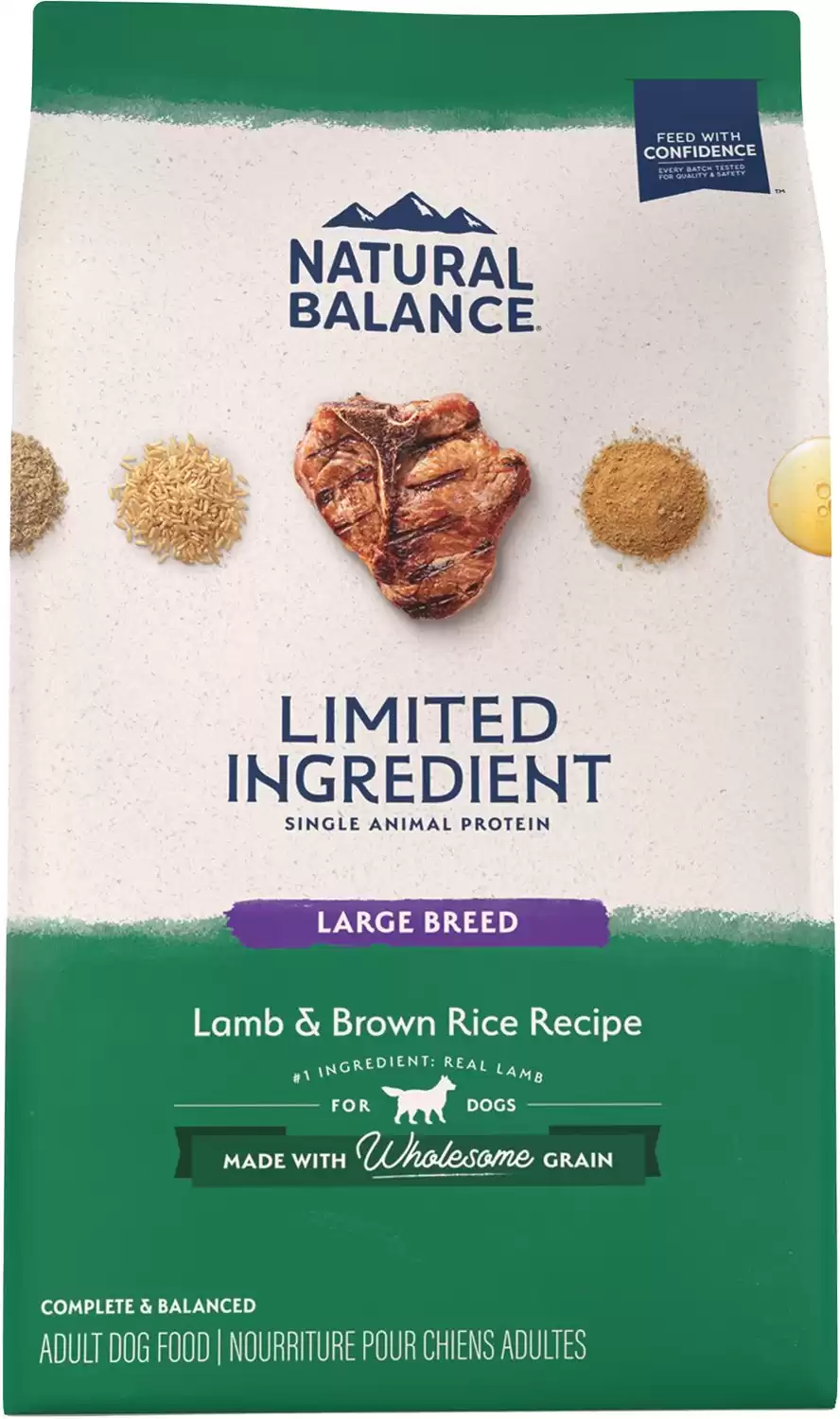Boxador
Canis lupus
Boxadors are extremely smart and catch onto backyard games very quickly!
Advertisement
Boxador Scientific Classification
- Kingdom
- Animalia
- Phylum
- Chordata
- Class
- Mammalia
- Order
- Carnivora
- Family
- Canidae
- Genus
- Canis
- Scientific Name
- Canis lupus
Read our Complete Guide to Classification of Animals.
Boxador Conservation Status
Boxador Facts
- Fun Fact
- Boxadors are extremely smart and catch onto backyard games very quickly!
- Temperament
- Devoted and playful
- Diet
- Omnivore
Boxador as a Pet:
- General Health
- Energy Level
- Shedability
- Trainability
- Intelligence
- Tendency to Chew
- Size
- Family and kid friendliness
- Yappiness / Barking
- Low
- Separation Anxiety
- High
- Preferred Temperature
- Average climate
- Exercise Needs
- High
- Friendly With Other Dogs
- High
- Pure bred cost to own
- $500
- Dog group
- Non-sporting
- Male weight
- 75-110 lbs
- Female weight
- 50-80 lbs
This post may contain affiliate links to our partners like Chewy, Amazon, and others. Purchasing through these helps us further the A-Z Animals mission to educate about the world's species.
View all of the Boxador images!
The loyalty and affectionate temperament of a Boxador makes it an excellent emotional support dog.
A Boxador is a mix between a purebred Boxer and a Labrador Retriever. Boxadors are intelligent dogs with mischievous, playful temperaments. They are known for their high level of energy, so they need plenty of exercise each day to keep them in healthy condition. They were bred to be companions and do well in households with children.
See all of our expert product reviews.
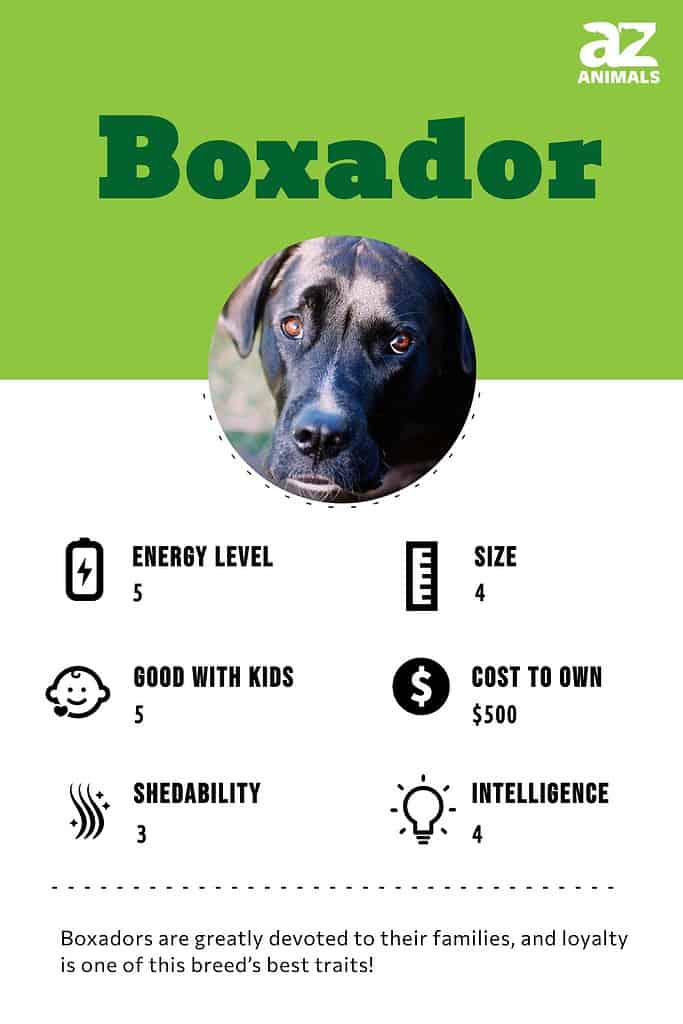
3 Pros and Cons of Owning a Boxador
| Pros! | Cons! |
|---|---|
| Good With Children Socialized Boxadors like to interact with and play with children. | High-Energy Dogs These dogs require at least 60 minutes of exercise each day to keep their mind stimulated and maintain good health. |
| Low-Maintenance Grooming Routine They are seasonal shedders but otherwise require a low-maintenance grooming routine. | Large Size A male Boxador can weigh up to 110 pounds so these dogs are not appropriate pets for an owner with a small home or apartment. |
| Easy to Obedience Train These dogs are smart and pick up lessons quickly which makes obedience training fairly simple. | Separation Anxiety These dogs love to be with their families. So, they suffer from separation anxiety when left alone. A dog may chew household items or destroy other property as a result of being left alone for several hours. |

Boxadors are seasonal shedders but otherwise are low-maintenance when it comes to grooming.
©Paul Donald/Shutterstock.com
Appearance
A solid build, square head, and large boxy muzzle are a boxador’s key characteristics. Its legs are proportionate to its body size without being rangy.
This rather serious-looking pooch also has a pair of ears that stand at the base, but flap at the tips, unlike a Corgi’s, German Shepherd’s, or a Husky’s which stand upright, or a Cocker Spaniel’s, or Dachshund’s which droop downwards.
Its tail is by no means as bushy as an Akita’s, a Havanese’s, or an Irish Setter’s. A boxador will often have a short coat that can come in brown, black, chocolate, fawn, gold, white, or yellow.
Health and Entertainment for your Boxador
See all of our expert product reviews.
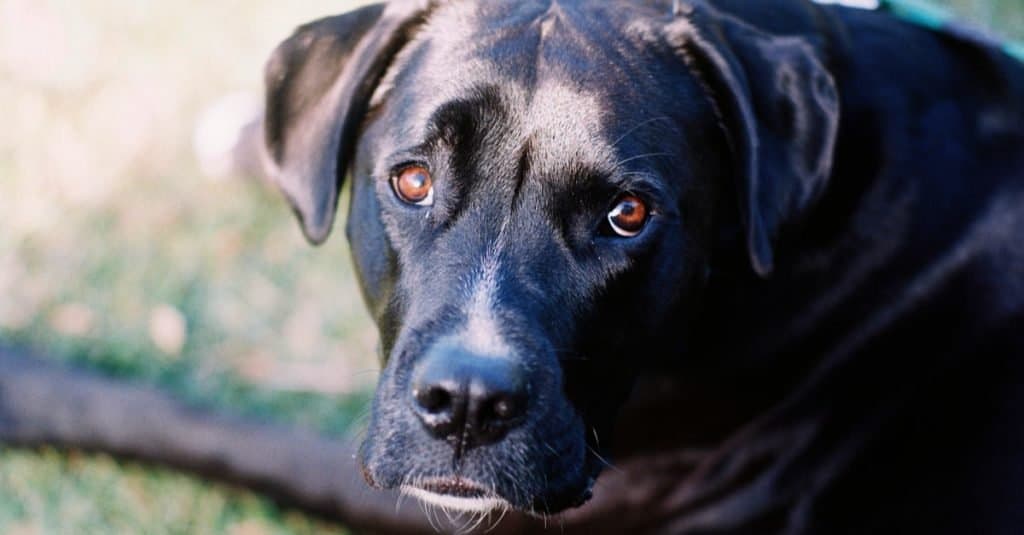
The Boxador has a square head and a large boxy muzzle.
©Luke Sadler/Shutterstock.com
Size and Weight
Boxadors are medium to large size dogs. A male can grow up to 25 inches tall and weigh as much as 110 pounds fully grown. A female can also be 25 inches tall but weighs around 80 pounds. At 9 weeks old, a puppy weighs around 10 pounds. These dogs are considered fully grown at 2 years old.
| Height (Male) | 25 inches tall |
| Height (Female) | 25 inches tall |
| Weight (Male) | 110 lbs, full-grown |
| Weight (Female) | 80 lbs, full-grown |
Evolution and History
The Boxador is a member of the hybrid group, and its history only goes back a couple of decades. It’s believed to have originated in America, likely during the 1990s when the popularity of “designer dogs,” particularly those crossed with Labradors, increased.
The Boxador’s parent breed the Boxer has a lineage that can be tracked 2,500 years back to the Assyrian empire. The modern Boxer was bred down in the late 19th and early 20th centuries from a bigger breed called the Bullenbeisser, which the German nobility used to hunt bears, bison, and wild boar. The name “Boxer” derives from the dog’s habit of playfully punching with its front paws. It has been used for a variety of roles over time, including assisting soldiers in World War I and II, and as a police dog, cattle herder, and guide dog for the visually impaired. Its popularity in the United States grew in the 1950s after a Boxer named Bang Away won Best in Show at the Westminster Kennel Club Dog Show in 1951 and became a celebrity. Boxers are now often listed in the 10 most loved dog breeds in the U.S.
The Labrador Retriever, the Boxador’s other parent breed, is a gun dog used as a duck retriever that was originally bred from fishing dogs in Canada’s Labrador Territory, which were also found in Newfoundland and called St. John’s Water dogs named after its capital. The modern Labrador was developed by breeding these dogs with British hunting dogs after sailors brought them to the U.K. in the 19th century. Like the Boxer, the Labrador also was used to assist soldiers and during the Vietnam War, they acted as scouts to find dead or wounded fighters or enemy locations. Labs make excellent guide dogs and assistance dogs, as well as helping in police, military, rescue, and lifesaving operations. The purebred Labrador along its many crossbreeds is hugely popular around the world.
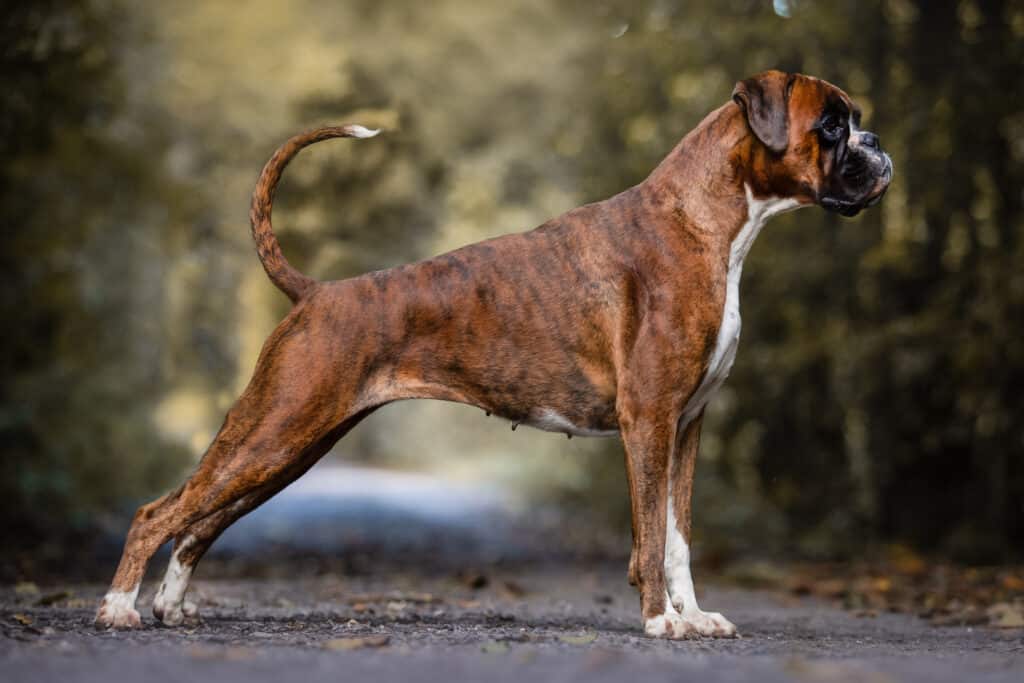
The Boxador’s parent breed the Boxer was developed from a bigger breed used by German nobility in hunting.
© nik174/Shutterstock.com
Common Health Issues
These dogs have some of the same health issues as their Boxer and Labrador Retriever parents. One of those issues is hip dysplasia. Bigger dogs are especially prone to this condition. Hip dysplasia is a condition in which the ball and socket of the hip joint are out of alignment. Limping and hopping are two signs of this condition. Sometimes physical therapy or supplements can help a dog with hip dysplasia while others need surgery.
A second common health issue of these dogs is allergies. Some of these hybrids are prone to food allergies while others have environmental allergies. Itching, red skin, or bald spots on a dog’s coat can be signs of allergies. A veterinarian can help to determine what a Boxador is allergic to and what can be done to relieve this condition.
Another health issue of these dogs is called bloat. Bloat is when a dog’s stomach fills with a combination of air, food, and liquid. The problem comes when the dog’s stomach begins to block blood flow to other organs. Panting, foaming at the mouth, a distended abdomen, and retching are all signs of bloat. A Boxador, or any dog, with these symptoms, should be taken to the veterinarian immediately for quick treatment.
The most common health issues of these dogs are:
- Hip dysplasia
- Allergies
- Bloat

Like its parent breeds, the Boxador is prone to hip dysplasia among other health concerns.
©Erik Lam/Shutterstock.com
Temperament and Behavior
Boxadors are greatly devoted to their families. In fact, loyalty is one of this pup’s most memorable traits. It has a mischievous personality and an affectionate temperament. Boxadors are a product of two high-energy dogs. So it should come as no surprise that a Boxador has a high level of energy!
Socialized Boxadors are good with children. When a Boxador goes through socialization as a puppy, it knows what type of behavior is acceptable in a household. A family looking for a smart, fun-loving dog with a sweet personality won’t go wrong with a Boxador!
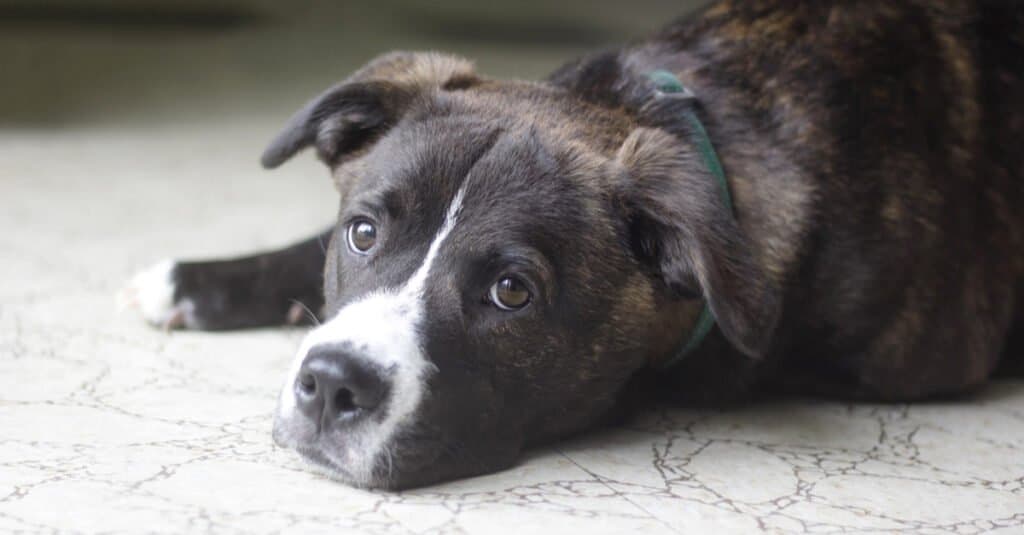
Loyalty is one of the Boxador’s best traits.
©Ashleycd1/Shutterstock.com
How to Take Care of Boxadors
Before getting a pet Boxador, it’s best to learn its grooming, dietary, exercise, and healthcare needs. Of course, a Boxador puppy and an adult dog need different types of care. Discover some important facts to keep in mind.
The Best Dog Food for Boxadors
The dietary needs of puppies and adult Boxadors are different. Check out some factors regarding the nutritional needs of this hybrid:
Puppy food: Protein in a puppy’s food supports healthy nail, skin, fur, muscle, and ligament growth. Lean protein can help to slow the development of hip dysplasia. Fat gives a Boxador puppy the energy it needs to stretch its legs and run around exploring its environment. Omega 3 and 6 fatty acids contribute to a puppy’s brain and eye development. Also, fatty acids help to heal red or itchy skin due to allergies. Calcium gives these energetic puppies strong teeth and bones. Both puppies and adult Boxadors should have access to clean water at all times for both hydration and to help with digestion.
Adult dog food: Adult Boxadors need protein in their diet as well. Protein maintains healthy muscles, ligaments, and tendons. Even if an adult Boxador starts to show signs of hip dysplasia, a daily supply of lean protein is always beneficial. A limited supply of fat gives adult Boxadors the energy they need to run and jump around. Vitamins C and E are antioxidants that can help to fend off allergies and strengthen the immune system of an adult dog. Calcium supports healthy bones and teeth.
Another solution for Boxadors’ potential allergies is to find a limited-ingredient dog food that excludes common allergy-causing ingredients.
Therefore, our pick at A-Z Animals for the best dog food for Boxadors is Natural Balance Limited Ingredient Diet | Large-Breed Adult Dry Dog Food with Healthy Grains.
You won’t find heart-hazard legumes like peas and lentils in this gluten-free dog food made without corn, wheat, or soy. If you opt for the lamb recipe, your allergy-prone Boxador will benefit from the alternative protein and the brown rice as a wholesome carbohydrate with fiber for smooth digestion. The muscles will grow and stay strong from the amino acids, and the calcium generates tough bones and cartilage in the joints that hold up under Boxadors’ large size.
Check Chewy and Amazon for this product.
- Wholesome grains provide the fiber for a healthy digestive system
- Tailor-made for large breed dogs
- Amino acids and vitamins and minerals help maintain healthy skin and a shiny coat
- Free of corn, soy, gluten, preservatives, or fillers
Maintenance and Grooming
Boxadors shed a moderate amount of hair. Adding to that, they are seasonal shedders so the shedding may get heavy for a few weeks, then slow down. This amount of shedding requires a low-maintenance grooming routine.
Brushing a Boxador just once a week is a satisfactory grooming routine. However, when it enters a seasonal shedding period, it’s best to brush the dog once each day. A comb is a good grooming tool for going over the dog’s coat once a week. Also, an owner can use a soft brush with boar’s hair bristles to stir up natural oils to make the Boxador’s brown, black, white, or brindle coat shine. A brindle coat is a mixture of black, brown, and white streaks. During seasonal shedding, a de-shedding comb is good for removing loose or dead hair. An owner may want to groom the dog outdoors during this period so the hair can just float away.
Dry or red skin is a sign of allergies. A dog can even have bare spots due to excessive scratching. Grooming this hybrid dog once per week allows an owner the opportunity to notice any skin issues that need to be addressed.
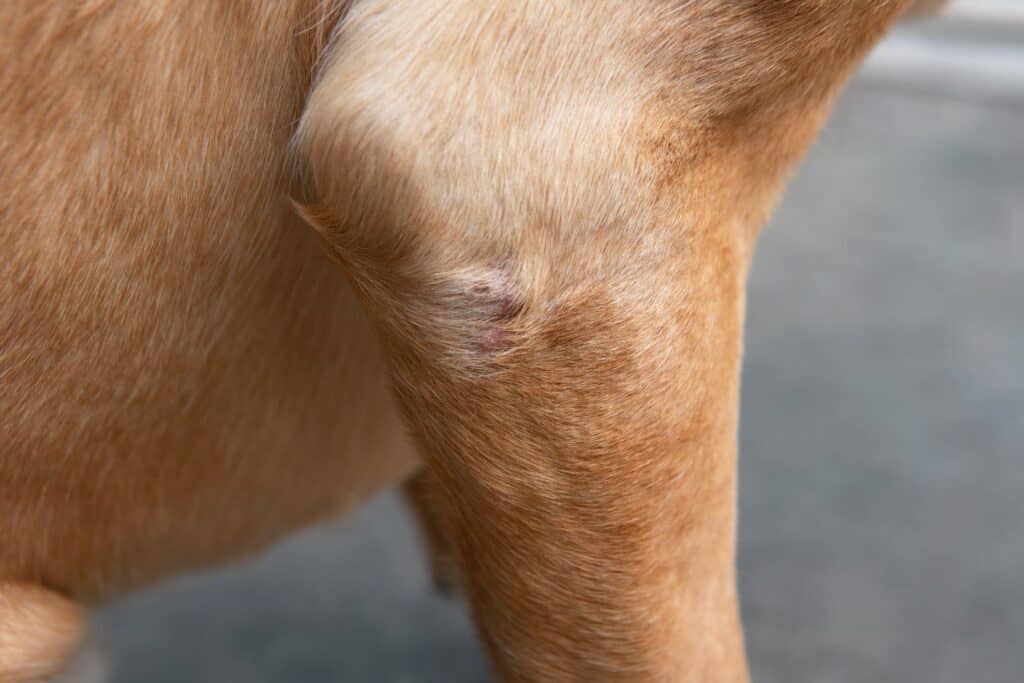
Redness and dry skin are signs of allergies for Boxadors.
©9gifts/Shutterstock.com
Training
These dogs are smart and pick up obedience lessons easily. One of their parents, the Labrador, is especially well-known for being eager to please. So, the ease of training is no surprise!
Another dog that’s easy to train is the Golden retriever.
Exercise
This is an important issue for anyone considering a Boxador. These dogs need a lot of exercise to burn off the incredible amount of energy they have. This means at least 60 minutes of exercise each day. Running in a field, hiking on a trail, or romping around at a dog park are all excellent ways to get this dog the exercise it needs.
Of course, some level of exercise is needed for all dog breeds. But, the dog has a very active mind and when it’s sedentary it gets bored. Unfortunately, a bored Boxador can turn into a destructive pooch! Having a collection of durable, size-appropriate toys around the house can help to fend off boredom in this dog as well.
These dogs aren’t appropriate for apartment living due to their large size. They are likely to cause damage in a small space.

Boxadors need at least an hour of outdoor exercise each day.
©Milaspage/Shutterstock.com
Puppies
These puppies are larger than many breeds of puppies so they should be given an appropriate amount of space once they start moving around. They are energetic even as puppies so the more room they have to explore the better!

Boxador puppies enjoy more room to explore as they are larger than other breeds when young.
©Cinda-lu/Shutterstock.com
Boxadors and Children
These dogs are good with kids. The only consideration is making sure the dog has been socialized from puppyhood and knows how to act around children of all ages. Remember, this is a medium to large size dog and can run very fast. This may result in an unintentional collision with a child. In short, the interactions between a Boxador and very small children should be monitored.
Dogs Similar to Boxadors
Other dogs similar to Boxadors include the Corgidor, the Golden retriever, and the Boxerdoodle.
- Corgidors – Corgidors and Boxadors have the same playful temperament and curious mind. However, Corgidors are smaller in size than Boxadors.
- Golden retriever – The Golden is another smart dog with an affectionate temperament. These dogs are about the same height, but Boxadors are usually heavier.
- Boxerdoodle – The Boxerdoodle and the Boxador both have a loyal temperament and suffer from separation anxiety. But Boxerdoodles are lighter weight than Boxadors.
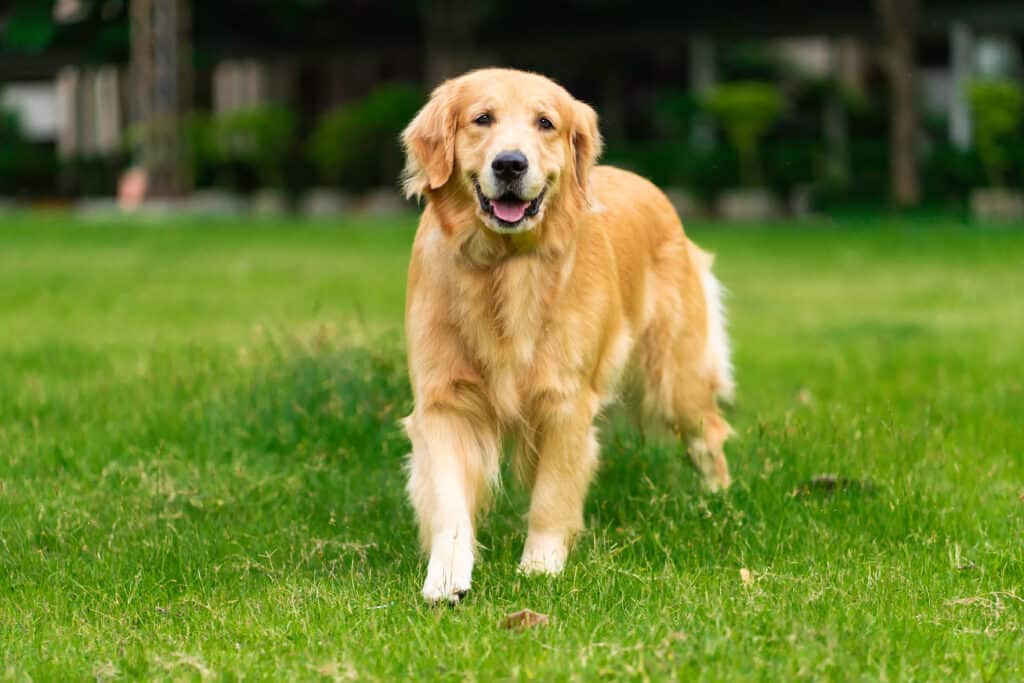
Golden retrievers are around the same height as Boxadors but typically weigh less.
©Burin P/Shutterstock.com
Popular Names for Boxadors
Popular names for these dogs include:
- Maximus
- Bruiser
- Lola
- Lucky
- Rosie
- Bentley
- Maggie
- Cooper
Boxador FAQs (Frequently Asked Questions)
What is a Boxador?
When breeders put a Boxer with a Labrador retriever it resulted in a new hybrid breed called the Boxador. It’s smart, devoted, mischievous, and always ready to run around. Boxadors are known as good dogs for families with children. They can have a black, white, brown, or brindle coat.
How much does a Boxador cost to own?
Breeders charge an average of $500 for a Boxador.
The vet costs for this hybrid dog range from $300 to $600 a year.
The food costs for a Boxador are between $100 and $150 per month. This varies depending on what type of food an owner buys, where it’s purchased, and how much the dog is fed.
Is a Boxador good with kids?
Yes, these dogs are known to be good with children. It’s important that these energetic dogs are socialized early on, so they understand what acceptable behavior is.
How long does a Boxador live?
The lifespan of a Boxador is 12 to 15 years.
Are Boxadors aggressive?
Boxadors are not known to be aggressive. But any dog can become agitated if it feels threatened by something.
Is a Boxador a good dog?
Yes! These are friendly, affectionate dogs.
How much does a Boxador cost?
Breeders charge an average of $500 for a Boxador.
An individual may want to check a local animal shelter or rescue organization. These places charge less for this hybrid dog.
What is the life expectancy of a Boxador?
These dogs can live to be 15 years old. Of course, if a Boxador is in especially good health, it can live longer than that!
Thank you for reading! Have some feedback for us? Contact the AZ Animals editorial team.
Sources
- Pet Guide, Available here: https://www.petguide.com/breeds/dog/boxador/
- VMCCNY, Available here: https://www.vmccny.com/gastric-dilatationvolvulus-bloat





